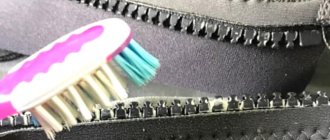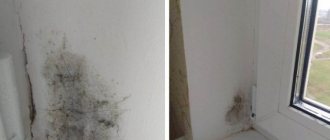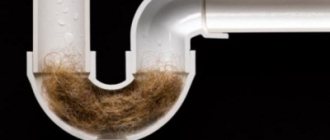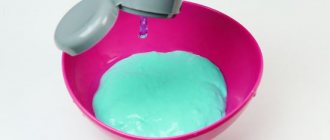What are the causes of blockages?
Before clearing blockages in the sewer system, it is necessary to determine the cause of their occurrence. Moreover, there are places where they form most often, for example in the sink or in the place where the sewer pipe from the bath and kitchen goes into a common riser. And given the ability of cast iron pipes to silt up the inner diameter, the likelihood of blockage in this area is very high. The siphon in the sink often becomes dirty due to food residues draining into it. Another common problem is the presence of grease on the inner walls of the pipeline.
The cause of blockage of the riser or other communication veins may depend on the pipes used; they are of two types:
- Cast iron.
- Plastic.
In the first case, cast iron tends to collect plaque and rust inside the pipe. Corrosion causes the walls to become uneven, which encourages waste collection. Often, when dismantling them with a diameter of 110 mm, the passage was about the size of a little finger (2–3 cm).
Plastic piping is prone to clogging. In most cases, it is necessary to clean the sewer from grease due to improper installation of the route (failure to comply with the angle of inclination). A plaque appears that gradually fills the entire internal diameter of the pipe.
Types of blockages
There are three varieties: Operational. A blockage forms in the sewer pipe as it is used and eventually forms deposits on the walls of various formations. Gradually they reduce the diameter of the pipe. Restoration requires thorough rinsing.
Mechanical . The problem appears when a large object, rag, etc. gets into the pipeline. To eliminate it, you must completely remove the item.
Technical . Appears due to damage to the pipeline. Explained by the presence of a counter-angle, insufficient slope or a large number of turns. This type of congestion depends on non-compliance with installation technology.
What to do if baking soda and vinegar don't help
If home remedies do not help to cope with the blockage, you can resort to the use of the following specialized tools and compositions:
- Purchased preparations in the form of solutions, powder mixtures and gels. Such products have a high level of effectiveness. They differ in composition and purpose. When purchasing a drug, you should carefully read the instructions for use and the information provided on the package.
- Sewer cable. This device is made in the form of a long cord with a pointed or spiral tip. This tool can clear any congestion.
- Plunger. This is the simplest device for mechanical cleaning of the sewer system. In most cases, it is a rubber hemisphere with a wooden or plastic handle for easy use.
You need to use store-bought and homemade products to remove blockages in the pipeline, observing safety rules and processing technology.
How and with what to determine the location of the blockage?
If the sewer is clogged, you must first determine the intended location. In a private house, we will conditionally divide the entire system into two zones: the house and the street.
In the house you should pay attention to the following places:
- In the siphon under the sink in the kitchen and bathroom.
- In a corrugated pipe under the washbasin.
- At the exit of the riser to the street.
- At the connection of smaller pipes with a larger diameter.
There may be such places on the street:
- At the outlet of the pipe in the septic tank.
- On the section between the wells.
Types of cleaning at home
There are many ways to clean a drain:
- Mechanical.
- Electromechanical.
- Chemical.
- Hydrodynamic.
- Thermal.
- Pressure.
Let's consider all the features of these methods for clearing sewers when removing blockages.
Mechanical
Mechanical is carried out with a cable for punching and cleaning the sewer. There are several types of it:
- Cable.
- Tape.
- Spring-loaded.
- Spring with rod.
Cable. A standard size sewer cable has a cross-section of Ø6 mm. Made from galvanized steel. It is strong, durable, elastic, flexible. The end of the cable is specially crimped so that it does not unwind. It looks like a brush and you can wrap hair dirt around it. It is best to clean it at home when its length is up to five meters.
Tape . Flat cable for cleaning sewer pipes. The width of the tape reaches up to 40 mm. Because of this specific shape, it is difficult for them to go through a large number of turns (due to the ability to bend only in one plane).
Taking this feature into account, ribbon plumbing cable is used for punching pipes of large diameter and length, since it will definitely not twist along its course.
Spring with rod. It is used by professionals.
Mechanical cleaning of the home sewer with a spring cable allows you to remove complex and large blockages. It is based on wire and spring.
A galvanized cable located inside the spring is used as a rod.
The cable diameter ranges from 13 to 16 mm. As for the length, it reaches up to 60 m.
Spring-loaded . The cable consists of one spring.
It's hollow inside. Diameter no less than 9 mm. The cable must be equipped with a handle for its rotation. It is used for pipes of small diameter, as well as for minor blockages.
How to break through a sewer yourself with a cable?
One end of the cable should be directed into the pipe and gradually pushed through. At the same time, you need to turn the handle.
Due to this, the cable will sink further and, thanks to rotation, break up the clogged area.
Advice! Cleaning a sewer in a private home with this equipment should only be performed by two people. One turns, and the second pushes the cable in the desired direction.
To achieve the best results, this equipment is equipped with additional attachments. Their use allows you to quickly remove debris accumulation. Nozzles:
- Hook.
- Harpoon.
- Pike.
- Ruff.
- Pear-shaped drill.
- Shovel-arrow.
- Cone drill and others.
Electromechanical
Clearing the blockage can be done using electromechanical equipment. The essence of the technology is a rotating steel wire. To achieve a better result, various attachments are put on its end:
- Drilling.
- Scraper.
- Pear-shaped.
- Hook-shaped.
The choice is made based on the goal or the nature of the problem. They can crush dirt. The spiral rotates thanks to an electric motor, and this special equipment has a gearbox that feeds the wire. Cleaning large sewer networks using this method allows achieving better results, since the length can exceed 100 meters with a pipe diameter of up to 600 mm.
How to clean and rinse the siphon?
A clogged siphon is considered a simple task, and even a schoolchild can get rid of it on his own.
Advice! The easiest way is to disassemble the siphon. If this is not possible or there is simply no desire to get your hands dirty, then chemical and mechanical methods are used.
Can be used for a siphon - plunger. Sharp up/down movements can push through the dirt. If it is not there, then clean the drain with vinegar and soda.
Vinegar and soda
Cleaning drains with vinegar and soda is performed in the following sequence:
- Pour a small amount of dry soda (half a pack) into the siphon through the drain hole.
- It is important that the soda does not get stuck through the protective grille. To do this, you can push it with a stick or build a funnel out of paper.
- Then pour in half a liter of vinegar.
- A hissing reaction will then occur.
- As soon as the reaction stops, pour out the boiling water.
If the result is not achieved, the procedure can be repeated.
Advice! Before you clean the sewer pipe and siphon with soda and vinegar, you need to make sure that the problem is in this place.
Lemon acid
First, citric acid is poured into the siphon hole, and then water, or preferably vinegar, is poured in. The hissing process will remove dirt very quickly.
Cleaning the kitchen sink
To clean the sink, you can use ordinary laundry soap (72%). This is done according to these instructions. A bar of soap dissolves in boiling water. The prepared solution must cool, after which excess water is drained from it. As a result, a soapy substance should remain at the bottom of the container, which must be applied to the sink. Then it needs to be treated with a vinegar solution.
You can also rub the moistened sink with soda powder, and after 10-15 minutes, rinse off the remaining residue and wipe with a cloth.
A mixture of acetic acid and soda powder copes well not only with organic stains, but also with limescale and rust stains. To do this, the substance must be diluted with water until a thick consistency is obtained. After this, acetic acid is poured into the mixture. The prepared solution is used to treat contaminated surfaces and leave for 30-40 minutes. Then they are washed with water and wiped away from stains.
Preventing blockages
It's better to prevent the problem from happening than to figure out how to clear your sewer pipes of contaminants. Therefore, experts recommend carrying out preventive work:
- Once a month pour boiling water. Just don't pour it down the toilet, it will crack.
- Clean siphons once a month using soda and vinegar or disassemble them.
- When washing dishes, use warm water and detergents.
- Pump out wastewater from the septic tank in a timely manner.
- Use chemicals for prevention.
How to get rid of fat in pipes
A blockage in a pipeline is an extremely unpleasant phenomenon that creates great inconvenience when using your own home or apartment. This problem can be solved using different methods: using special compounds, improvised substances, professional hydrodynamic washing, mechanical cleaning. Each of these methods has its own advantages and disadvantages, and is more suitable in one case or another.
Chemicals
In difficult situations, cleaning sewer pipes from grease is carried out with special preparations designed for such a procedure. They come in different forms (tablets, powders, liquid), but they always contain an alkaline component. During the interaction of such compounds with fat deposits, a violent chemical reaction is observed, which over time leads to the complete dissolution of unnecessary accumulations. The remains then go down the drain under strong water pressure after turning on the tap.
Particular attention should be paid to products with a pronounced antiseptic effect. Their packaging usually contains o. Such mixtures contain beneficial bacteria that eliminate the real cause of bad odor.
"Mole"
Cheap, highly sought after grease breaker for sewerage. It is produced in powder form (with an antibacterial effect) and also in liquid form. On the market of modern household chemicals there are many products (from different manufacturers) with the name “Mole”. Therefore, the results of their use vary slightly. However, many users prefer to buy this particular drug.
Method of use:
- Pour or pour the contents of the package into the hole.
- Wait two to three hours.
- Rinse the pipeline generously with hot water.
The popularity of using the Mole cleaning product is due to its ease of use and affordable cost Source montagtrub.ru
"Bagi Pothan"
Belongs to highly effective products that can eliminate food waste, paper inclusions, limescale or grease deposits. Using this composition, you can clean the sewer in just a couple of minutes. But it is extremely important to adhere to safety measures.
How to use:
- If possible, open the windows and completely remove the liquid from the sink.
- Holding the drug at arm's length, open the package and quickly pour in the contents.
- Pour 300 ml of heated water into the drain hole.
- Wait a few minutes.
If this chemical does not work immediately, it can be reapplied.
The powerful and effective remedy “Bagi Pothan” clears most blockages without much physical effort or the use of a plumbing cable Source netzasory.ru
"Mister Muscle"
It is produced in the form of granules or thick gel. The latter is able to penetrate into a problem area, even if the sink is filled with liquid. The blockage is usually cleared within 15 minutes.
Mode of application:
- Pour half of the packaging capacity into the pipeline.
- Wait a quarter of an hour.
- Thoroughly rinse off any remaining fat deposits with hot water.
Attention! “Mr. Muscle” is a fairly caustic chemical; if it comes into contact with unprotected skin, it can cause a severe burn.
The “Mr. Muscle” product completely cleans clogged and poorly flowing drain pipes, destroys microbes, and eliminates unpleasant odors Source chocomart.kz











